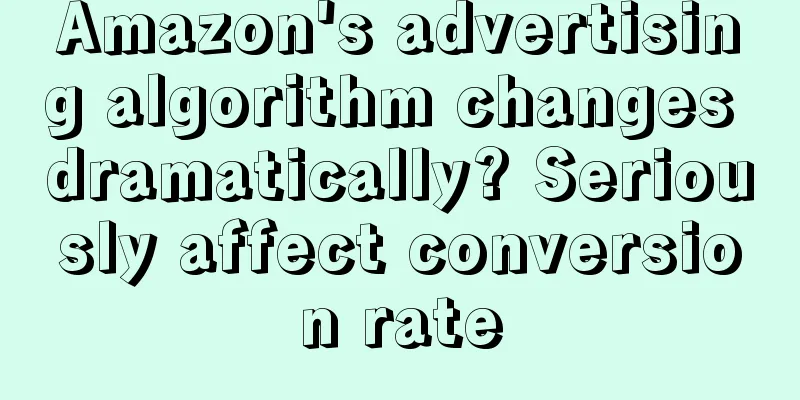Amazon's advertising algorithm changes dramatically? Seriously affect conversion rate

|
In the past two days, many places have reported that the broad matching logic of Amazon’s in-site advertising has changed, which directly affected the conversion rate of advertising campaigns! This news mentioned that the change in the advertising logic can be summarized as follows: the broad match mode will split the keywords set by the seller and expand them separately. For example, if the seller sets a keyword combination of A+B, before the logic is changed, the broad match will only separate the two words for delivery, that is, A, B and A+B, and will not expand the separated words again. After the revision, the expansion after the word splitting is added, that is, on the basis of the previous one, there will be combination words such as A+X and B+X. As for what kind of word X is, the algorithm will grab it according to A and B respectively. In fact, Amazon has a relatively detailed explanation in the background, and some sellers have also retained official annotations before and after the advertising logic changes. The above are the rules before the change, and the below are the rules after the change. I found a Chinese version and put it below for you to take a look. The first sentence here clearly states that in the broad match mode, the customer's search terms can contain keywords in any order, and may also include singular, plural, variants, synonyms and related words. It seems that Amazon's split-word matching seems to be in line with this logic, but this logical change that everyone is discussing actually deviates from the goal of broad matching. For example, "cotton shirts" is a relatively standard A+B keyword, but the weight of this word is obviously different. As a modifier, cotton only narrows the scope of the main word shirts. If you expand "cotton" without the main word, and use a bunch of words that have nothing to do with the product, such as "cotton dress" and "cotton sheets", this change can only bring more useless traffic. The result is that the exposure is very large, but the conversion is very small. Over time, Amazon will reduce the push traffic due to poor conversion of advertising activities, and fall into a vicious cycle. Matching search terms that are completely unrelated to the main term is not the purpose of Amazon’s in-site advertising. The occurrence of this situation only means that there is a certain deviation between the current situation and the purpose. Whether to modify the algorithm or stick with it depends on why Amazon wants to make changes at the algorithm level . “ The logic behind Amazon’s advertising algorithm changes This wave of algorithm updates happened right after the advertising department was laid off. We all know that when Amazon faced its first deficit in the first quarter of last year, it was the profits from AWS and the advertising department that made up for the losses in the mall business. The advertising business is also one of Amazon's fastest growing departments. Although the advertising department was laid off, the revenue from advertising must not go downhill. So what Amazon can do is to make small changes to the existing functions to increase advertising business revenue. Broad match conversion rate is not as good as accurate match, and it is usually used by sellers to expose new products, but this does not mean that sellers are willing to spend money in exchange for a lot of invalid traffic that has no possibility of conversion. This update is obviously Amazon's attempt to earn more advertising revenue, lowering the matching threshold of broad match and giving sellers a lot of invalid exposure, so it is possible that broad match will not be as good as automatic advertising. Amazon only wants to collect money without caring about the results, so sellers will naturally vote with their feet and stop using broad matching as a method of advertising, turning to precise, automatic advertising, or even SB advertising and display advertising. |
<<: Amazon workers return to work en masse! The platform's last measure to reduce costs
>>: Amazon's new feature is now fully available! "Built-in Tiktok" brings new opportunities
Recommend
How to find a niche market and maximize profits in 2019? 3 steps are enough!
Niche marketing focuses on an audience interested...
What is Haitong Cross-border Finance and Taxation? Haitong Cross-border Finance and Taxation Review
Haitong Cross-border Finance and Taxation is a com...
What is Central Group? Central Group Review
Central Group is a Thai department store chain tha...
What is ReviewMeta? ReviewMeta Reviews
ReviewMeta is a tool that analyzes existing produc...
See how big selling companies quantify their operations!
Profit Statement Inventory Monitoring Sheet Ranki...
What is Duoke? Duoke Review
Born for cross-border sellers, it can log in quick...
What is Prime Pantry Box? Prime Pantry Box Review
Prime Pantry Box is a service launched by Amazon s...
Shopify lays off 10% of its global workforce! CEO admits misjudgment of consumer trends
It is learned that on July 26, Shopify officially ...
What is CoralGlobal? CoralGlobal Review
CoralGlobal was established in September 2016. It ...
What is iChannelSolution? iChannelSolution Review
iChannelSolution is a high- tech enterprise specia...
What is Yellow Pages Scraper? Yellow Pages Scraper Review
Yellow Pages Scraper is a powerful foreign trade c...
What is suchprice? suchprice review
Suchprice is committed to collecting international...
What is Dekesen Business? Dekesen Business Review
Dekosen Business Consulting was founded in London,...
Breaking news! A large number of Amazon sellers violated regulations and broke the shipping restrictions, resulting in their accounts being blocked!
Since Amazon’s US site restricted shipments, many ...
The US and Europe are on strike again! Delivery at these stations will be affected...
The big promotion just ended. News of strikes in v...









